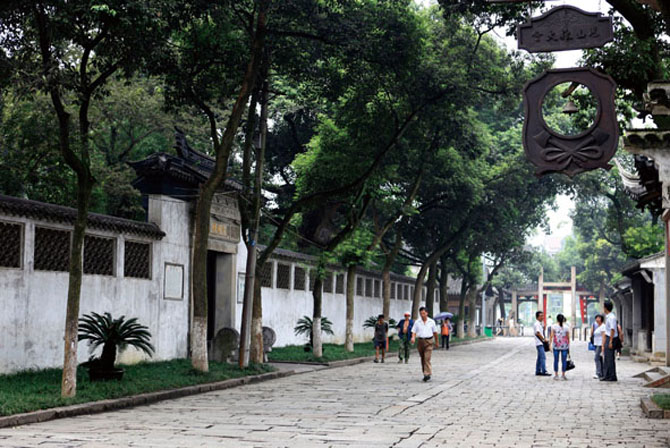Written by: Lou Qingxi
Posted on: January 16, 2013 |  | 中文
| 中文
The Jichang Garden of Wuxi, in Jiangsu Province, is a famous hillside residence garden in South China, well known for its meticulous work in construction and unique artistic style. The Jichang Garden has a history of over 400 years, initially serving as the residence of Qin Yao, Minister of the Board of War of the Xuande Period (1506-1521 AD) of the Ming Dynasty. By the 19th Year of the Wanli Period (1591 AD), the descendants of Qin Jin remodeled the residence into Jichang Garden, and the garden has been remodeled several times ever since. The garden not only has the typical charm of the gardens of South China and the grace of re-created nature, but also stands out with a unique appeal, having been cleverly blended into nature and built against the hills.
Walking into the west side of Jichang Garden, ancient trees, secluded valleys and the sound of the springs give one the illusion of nature in wild, and artificial hills can be seen everywhere, taking up as much as two thirds of the entire area. Planted on the hills are trees and bushes, and valleys and gullies run along the shape of the hills. Springs led in from Huishan Mountain drop from all levels of the slopes, singing and tinkling to form the scene of the ‘music box gully.’
In the eastern part of the garden lies a pond, narrow shaped with the long sides on the north and south and the narrow sides on the east and west. The pond takes up as much as 17% of the total garden area, and is called Jin Hui Yi, which means ‘Ripple of the Pooled Brocade’. The water is divided into two areas of north and south, breaking up the monotony by a long stretch of water. At the northern end of the pond there are flat bridges and covered bridges across the water, adding visual interest to a not-so-big water area. Finally, a ‘water tail’ is built at the very northern end, camouflaged by a covered bridge, the water giving the illusion of having a source without an end. Although limited in size, the Jin Hui Yi is nevertheless full of visual interest and does not seem at all cramped with its winding riverbanks and multiple levels of water partition.

In comparison with the hills and water, the architecture does not seem to be much. Except for a few temples, ancestral halls and chambers near the entrance, the other few pavilions, platforms, towers and bridges are all scattered around the pond. The Fish Watching Fence at the mid-section on the eastern bank of the pond protrudes into the water and becomes the visual center of the entire pond, from where a full view of the Private Gardens of the Ming and Qing Dynasties on the hills on the western bank can be obtained. The Jiashu Hall at the north of the garden is built on a high and open space, serving as the main view of the entire garden. Looking up from there, the Huishan Mountain can be seen on the opposite side, and looking back there is the Xishan Mountain and the shadow of its pagodas. Watching the spring ripples before the eyes, it virtually seems like a walk in a painting. Although the Xishan and Huishan Mountains are not in the gardens, the view far exceeds that if they were in the garden. The mere two and a half mu (about 300 square meters in area) of the narrow land is a feast for the eye with layer after layer of scenery without end.
Because of its clearly defined plans, with meticulous attention paid to the styles of hills, rocks and ponds, as well as the treatment of architectural details, scenes of unique beauty have been created within a limited sphere. What is especially noteworthy is that the garden's mountain and woods environment, with heavy and dense hills and water highlighted with scattered buildings, have fully inherited the intellectual garden style since the Tang and Song Dynasties and thus deserves to be rated as a top-grade garden of the Ming and Qing Dynasties.
You may also like: